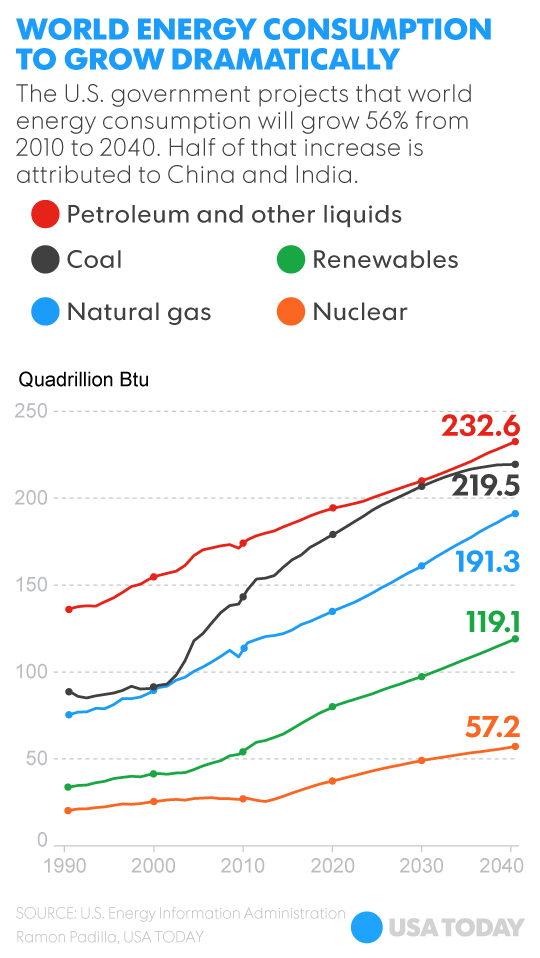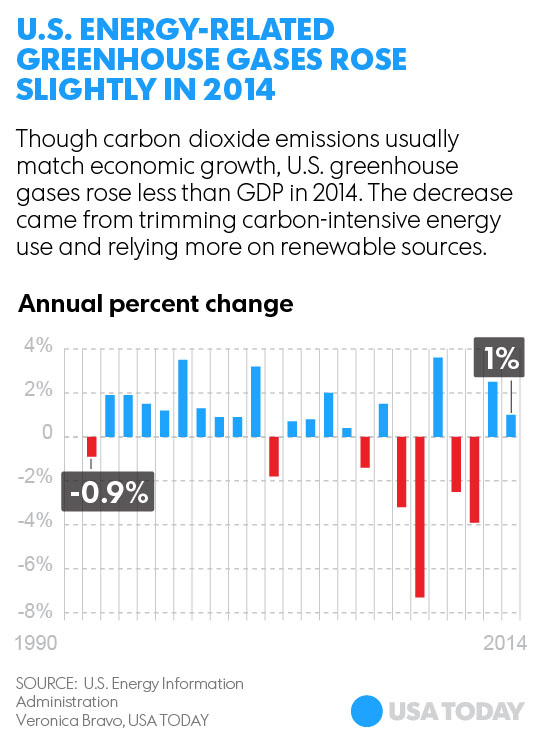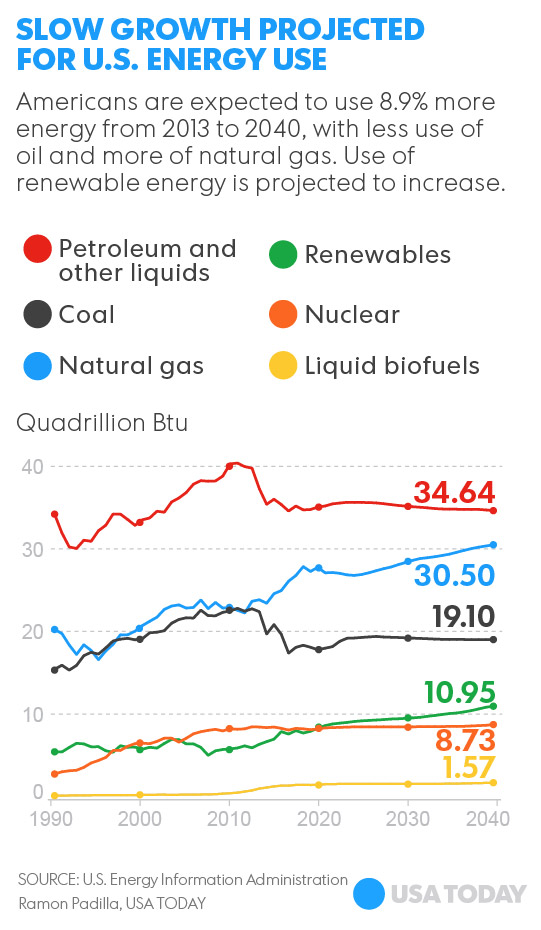This story was originally published by Donnelle Eller with The Des Moines Register.

Emily Heaton says clean energy from the 12-foot tall miscanthus she grows at an Iowa State University farm can help cut the carbon that’s warming the planet.
“I should be able to start my truck or turn on my lights at home, and it makes the air cleaner,” said Heaton, a 37-year-old agronomy professor who is researching how to use perennial grasses to cost-effectively generate electricity and fuel.
At Caltech, 30-year-old Sonja Francis searches for a catalyst that will turn sunlight, carbon dioxide and water into a fuel that can power our cars, trucks and other vehicles. “There was a time when we couldn’t fly airplanes. We didn’t have cars,” Francis said. “What seems impossible won’t always remain impossible.”
Or maybe the next generation of energy will come from river or ocean tides, from “windmills” floating 2,000 feet high in the sky, or from spent nuclear waste. Or the answer might lie with removing carbon from the air and reusing it.
 The world’s leading nations — and some of its richest business leaders — propose investing billions of dollars to find technology that can transform how we power our countries.
The world’s leading nations — and some of its richest business leaders — propose investing billions of dollars to find technology that can transform how we power our countries.
“Energy drives the economy. But the world has been relying on — with the exclusion of nuclear — a series of technologies that we were using in the late 19th and early 20th century,” said Josh Freed, vice president for clean energy at Third Way, a political think tank based in Washington, D.C.
“There are any number of big, even seemingly small ideas, that could have dramatic impact on our energy system,” Freed said. “We need to put money into them to determine which one works and which ones fail.”
Growing concern about climate change has ignited a massive effort to develop new energy technologies that are dramatically cleaner than fossil fuels, which make up most of the world’s energy portfolio. Last month in Paris, 195 nations pledged to lower greenhouse gases that are believed to cause climate change.
But Scott Tinker, director of the Bureau of Economic Geology at the University of Texas at Austin, said major new energy sources are “multiple, multiple decades away.” And enchantment with them diverts attention from a more pressing climate change challenge: reducing carbon pollution that will come with exploding energy demand from developing countries, home to half the world’s population.
“They need coal and are using coal, and they need natural gas and are using natural gas,” said Tinker, producer of the documentary, “SWITCH.” “They’re not going to stop doing that. We need to deal with that, rather than just try to legislate … their fuel sources away.”
Bill Gates: Speed ‘energy miracles’
Scientists warn that human activities are creating carbon dioxide and other greenhouse gases that get trapped in the atmosphere. The gases are raising the average global temperature, which in turn triggers more frequent extreme weather events, including droughts, flooding and hurricanes.
Power generation leads the list of human activities that create the most carbon pollution, followed by transportation, industrial production, homes and businesses, farming and land use changes.
In emerging countries, about 1.3 billion people have no access to electricity. Microsoft founder Bill Gates sees the rising electricity demand from those nations as a call to vastly increase investment that will accelerate the discovery of “energy miracles.”
He has pledged to invest $2 billion over five years to drive the effort and has campaigned for countries and other investors to join him.
 Gates and President Barack Obama announced at the Paris talks that 20 nations would double their research and development investment to $20 billion, and 30 private investors would pour billions of dollars into the public-private initiative, although an exact amount wasn’t released.
Gates and President Barack Obama announced at the Paris talks that 20 nations would double their research and development investment to $20 billion, and 30 private investors would pour billions of dollars into the public-private initiative, although an exact amount wasn’t released.
The investment is long overdue, some experts say, especially in the United States, which has failed to fully embrace the idea that carbon is heating the planet. “We have felt the energy R&D budget has been woefully underfunded for years,” said Phyllis Cuttino, director of the clean energy initiative at The Pew Charitable Trusts. “It’s pretty remarkable because energy is our third-largest sector here in the United States, but we have only dedicated about $5 billion to it annually.”
By comparison, the U.S. government spends about $30 billion on health research each year and $80 billion annually on defense research. Federal investment helps push promising energy technology in universities or national laboratories, Cuttino said. Then it has languished. Ramping up energy technology requires significant investment, she said. “It’s not like Google, where it can be developed by two guys in a garage,” she said. “It has to be scaled.”
The Gates investment group “has really targeted that valley of death” where promising technologies perish for lack of investment, Cuttino said. Some scientists have to “rent out a factory” to determine if their idea is commercially viable, she said. “They just don’t have the infrastructure to do it themselves.”
Changes sought in government policy
Another vital piece to the puzzle: government policies that support low- or carbon-free energies, said Robert C. Brown, an engineering professor at Iowa State University. “We have to make sure that renewable fuels don’t just complement petroleum. They need to actually displace them,” said Brown, who is developing a process that can turn biomass like Heaton’s miscanthus into renewable fuels and chemicals. It creates a carbon byproduct — called biochar — that can be used to enrich depleted soils.
Brown said a carbon tax, for example, could discourage consumers from using fossil-based fuels — and generate money to develop new technologies. But even a “whiff of a tax” could spark a voter rebellion, “which is why politicians stay away” from that idea, he said. “I haven’t a clue how you convince voters that it’s worthwhile.”
Tinker, the Texas energy expert, said politicians rarely get policy right when it comes to energy. “Every time governments try to legislate energy changes, unintended consequences happen,” he said.
And even with government support, energy changes happen slowly, Tinker said, noting that wind and solar are still only a small portion of the U.S. electric generation mix after three decades of development. Wind and solar provided about 5 percent of total U.S. electricity in 2014, according to the U.S. Energy Information Administration.
 Tinker sees next-generation technology taking the same path. “It would take a tremendous amount to alter that path,” Tinker said. “It’s changing slowly, but not because of politics.”
Tinker sees next-generation technology taking the same path. “It would take a tremendous amount to alter that path,” Tinker said. “It’s changing slowly, but not because of politics.”
Heather Zichal, a former assistant to Obama on energy and climate change, said the president’s Clean Power Plan is already pushing utilities to shift to cleaner fuels — to natural gas, for example, over coal — and to add wind and solar. The controversial plan requires states to cut carbon pollution emissions by an average of about 30 percent below 2005 levels.
Costs are falling for renewable energy, solar in particular, and improvements in storing power will broaden its adoption, said Zichal, a senior fellow at the Atlantic Council, a Washington think tank. “We have to stop acting like this is an insurmountable challenge.
“It’s not going to happen overnight … but there are great opportunities,” she said, adding that Americans also will see energy efficiency gains in smart technology that manages the grids that deliver electricity to consumers, who also can monitor energy use in their homes. “Some of those technologies exist today — and some are still in the heads of our great innovators,” Zichal said.
Accelerating the pace of success, and failures, will be critical to getting to the right answers, said Third Way’s Freed. Private investors can “rigorously demand success or fast failure, much better than government can do,” he said.
Fast failure is a big piece of Francis’ job at Caltech.
She’s trying to find the catalyst that will turn sunshine, carbon dioxide and water into fuel such as methane or ethanol. The process seeks to replicate what happens naturally in plants through photosynthesis.
“One of my mantras is: It’s OK to fail, but you need to fail fast,” Francis said. “You don’t want to spend a lot of time on something that ultimately won’t work. You have to work quickly, learn from your mistakes, and go back to the drawing board.
“You don’t know when you’re going to find” a breakthrough, Francis said. But when you do, “then it’s full steam ahead.”
One Nation forums
A forum Thursday Jan. 14 in Iowa, on the future of energy, kicks off the USA TODAY Network’s One Nation series — 10 events in 10 cities on key topics shaping the presidential election.
Thursday’s forum in Des Moines will come less than three weeks before the Iowa caucuses. The second One Nation forum, focused on health care, will be held in February in Reno, Nevada, ahead of that state’s caucuses. The third forum, in March in Phoenix, Arizona, will focus on immigration.
For information on the One Nation forums, go to onenation.usatoday.com.
Calculate your carbon footprint
Are you helping or hindering the effort to reduce carbon emissions? Here’s where you can go to calculate your carbon footprint:
EPA Carbon Footprint Calculator